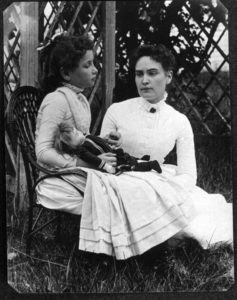When Anne Sullivan arrived at the Keller family’s home in Alabama, she was met by six-year-old Helen, a child both blind and deaf, waiting with an inquisitive spirit but also a world of frustration. Helen’s initial curiosity, displayed by rummaging through Anne’s bag, quickly turned into a tantrum when her mother intervened. This tumultuous beginning marked the start of a challenging yet transformative journey in teaching Helen Keller, a journey centered around the fundamental question: how could Helen, living in silence and darkness, learn to communicate?
The Initial Struggles and the Manual Alphabet
The early days were indeed a rollercoaster. Helen’s frustration manifested as outbursts, even resulting in a physical altercation where Anne lost a tooth. In one instance of defiance, Helen locked Anne in a bedroom and hid the key, highlighting the immense communication barrier that existed. Despite these turbulent moments, Anne persevered, recognizing glimpses of calm and curiosity in Helen. During these peaceful interludes, whether in quiet moments indoors or walks in the garden, Anne began introducing Helen to the manual alphabet. By spelling words into Helen’s hand, Anne aimed to bridge the gap to language.
Initially, Helen learned to mimic the shapes of the letters, but without comprehension. When Anne spelled C-A-K-E while offering cake, Helen didn’t connect these finger movements to the sweet treat itself. Similarly, M-U-G for her mug and W-A-T-E-R as she drank water remained disconnected concepts. Days turned into weeks, with Anne consistently spelling words, patiently waiting for a spark of understanding in Helen’s mind. One day, presenting Helen with a new doll, Anne spelled D-O-L-L into her hand. Helen, however, believed D-O-L-L to be merely the name of that specific doll, not grasping it as a universal descriptor for all dolls. This misunderstanding led to frustration, and Helen threw the doll to the floor in anger.
The Breakthrough at the Well-House
Seeking to soothe Helen’s agitation, Anne led her outside to the well-house. It was here, beside the cool, flowing water, that a pivotal moment occurred. Anne placed Helen’s hand under the water spout and, as the cool water gushed over her palm, Anne repeatedly spelled W-A-T-E-R into her other hand. The continuous sensation of the water, paired with the consistent spelling, acted as the catalyst. Suddenly, Helen understood. The letters W-A-T-E-R weren’t just random motions; they represented the cool liquid flowing over her hand, the same liquid in her mug.
A profound realization dawned upon Helen: everything had a name. This breakthrough unlocked a floodgate of understanding. In the moments that followed, Helen was eager to learn the names of everything around her, starting with her family – father, mother, sister, teacher. For months, Anne tirelessly taught Helen the name of every object she could touch, expanding her vocabulary and her world exponentially.
Expanding Communication Skills: Braille and Speech
With language as her foundation, Helen’s communication abilities blossomed. She began to learn in a way similar to hearing children, absorbing language from those around her, albeit through the tactile manual alphabet. Abstract concepts, once elusive, started to solidify. The concept of “think” emerged when Helen struggled with a bead-stringing task. Anne touched Helen’s forehead while spelling T-H-I-N-K, linking the word to the mental process she was experiencing.
Eager for further challenges, Helen ventured into new communication methods. Anne introduced her to braille, opening up the world of reading. Simultaneously, they sought out a speech teacher to help Helen learn to speak. This involved Helen placing her hand on the teacher’s mouth and throat to feel the vibrations and movements of speech, learning the oral alphabet through touch. Incredibly, within an hour, Helen could articulate sounds – M, P, A, S, and T. After just eleven lessons, she began forming short sentences understandable to Anne and her speech teacher, marking another significant stride in her communication journey.
Education and Advanced Learning
As Helen grew into her teens, Anne’s role evolved, becoming more of an interpreter and companion than solely a teacher. Winters were spent in Boston, allowing Helen to attend the Perkins School for the Blind. Here, she thrived in an environment where classmates understood the manual alphabet, enabling direct communication and fostering a sense of belonging. Their travels broadened her horizons, taking them to Grover Cleveland’s Inauguration, Niagara Falls, and the 1893 World’s Fair. Helen’s heightened senses of vibration and smell became invaluable, aiding Anne in interpreting the world around them.
At 14, Helen transitioned to the Wright Humanson School for the Deaf in New York. Her academic pursuits expanded to languages, studying French, Latin, and German. Remarkably, her German instructor learned the manual alphabet to communicate directly with her in German. Helen’s ambition led her to Radcliffe College, necessitating attendance at a mainstream prep school, the Cambridge School for Young Ladies. Here, Anne’s role was crucial, not only translating lectures but also acting as an intermediary between Helen and teachers unfamiliar with the manual alphabet. Textbooks needed to be translated into braille, presenting further logistical challenges.
Even preliminary Radcliffe exams were adapted for Helen. The proctor spelled questions into her hand, and Helen confirmed her understanding by spelling back before typing her answers on a braille typewriter. The proctor then spelled her answers back for review and edits. By her final Radcliffe exams two years later, they were translated into braille, allowing Helen to complete them independently. In 1900, Helen entered Radcliffe, with Anne by her side, tirelessly spelling lectures. In 1904, she graduated, earning her Bachelor of Arts degree, a historic achievement as the first deafblind person to do so. Helen Keller’s journey of learning to communicate was a testament to her extraordinary perseverance, and the transformative power of dedicated teaching and unwavering belief in the potential of every individual.
